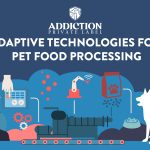With the humanization of the pet food landscape in recent years, manufacturers are faced with the challenge of continuously assuring customers that their brands advocate transparency across their business processes.
Earning and maintaining the trust of customers has always been the driving force behind pet food manufacturers. This intent to become more transparent throughout their production process has led to changes within the pet food landscape itself, and more and more, manufacturers are beginning to listen to their consumers.
Issues of transparency
Recent studies have highlighted how specific issues of health and wellness, visibility to the supply chain, sustainability and safety have overtaken traditional purchase drivers such as taste, price and convenience.
Moreover, the growing distrust on manufacturers from burgeoning target consumers, such as millennials, have encouraged them to become more open about their ingredients, production processes and ingredient sources in more ways than one.
For the most part, transparency now goes beyond the high-protein claim and dives even more into the quality of raw ingredients used in pet food. More importantly, it now tackles issues on how responsibly these ingredients have been sourced, while manufacturers align themselves to a wider perspective of transparency, hoping that a greater openness can eventually build more brand trust which can eventually translate into better sales.
The ability to trace product sources through a manufacturer’s supply chain has always been of paramount importance to the industry, but with recent developments in the pet food landscape such as ease-of-access to online information and the call for responsible sourcing, provenance and labeling have never been as important.
Connected consumers and transparency
The development and popularity of online platforms have driven pet food sales to new heights in recent years. The US online pet food and supplies market alone is estimated to reach more than US$6 billion by 2025 according to recent studies. China’s e-commerce likewise saw a 40.7 percent increase in online sales of pet food from 2016-2017, which fueled their pet food industry’s compound annual growth largely attributed to the fact that Chinese pet owners bought mostly online.
These statistics, among other growing factors, are enough for manufacturers to take notice of the exponential growth that e-commerce can offer to the industry, while debunking old fears surrounding it altogether.
That said, consumers have likewise become more and more connected compared to just a few decades ago, and their ease-of-access to information online has led them to be more cognizant of issues hounding transparency.
Today, it is common for consumers to check out forums and product review pages on social media platforms to get to know their pet food brands better and to which, manufacturers are equally expected to respond with greater transparency in terms of ‘clean labeling.’
Beyond these challenges however, manufacturers also need to look at the importance of social media marketing, and the growing impact of pet food influencers in determining how truly transparent labels are, and how much existing brand and label information can actually be shared, simplified or repurposed to address transparency.
Challenges ahead
Like most trends, the call for more transparency in pet food is largely the result of unrelenting clamor from consumers and their perceptions about how honest manufacturers should be about what they are putting into their formulations.
With the undeniable trend of humanization of pet food and other pet-related services as well as the call for ‘clean labels’, manufacturers find themselves in a challenging position to convince their retailers, and eventually the consumers, that their brands adhere to a competitive level of transparency that is enough to drive continued patronage.
Revolving around transparency are key issues like provenance, responsible sourcing and limited ingredient use, whose developments manufacturers must continue to take note of.
More importantly though, embracing transparency while promoting innovation in production involves manufacturers looking beyond their categories or assumed competitive advantages and moving towards crafting new ways to address consumers’ needs, both in short and long-terms.
Such a position compels manufacturers to ensure that transparency is carried across their production processes.
For those looking to produce through private label partners, it is imperative that manufacturers seek the guidance and support of seasoned partners with verifiable experience on premium pet food production, private label manufacturing, and a sound understanding of evergreen consumption.
Discover how Addiction Foods Private Label can help you ensure that your pet foods are made as transparently as possible, in terms of sourcing, production and labeling.
Talk to us about starting a partnership.










